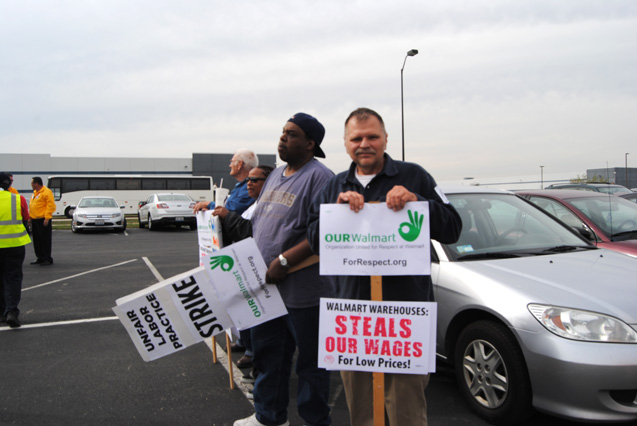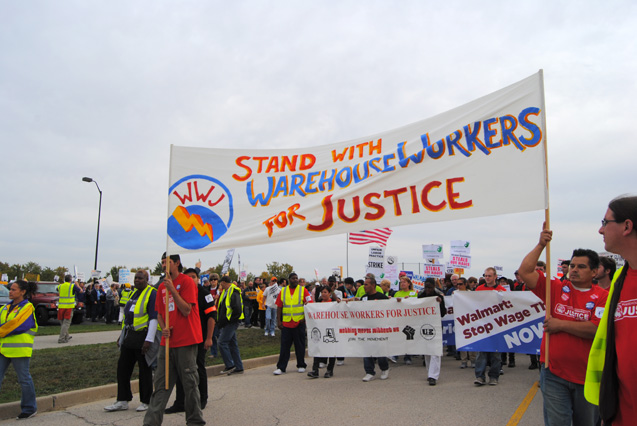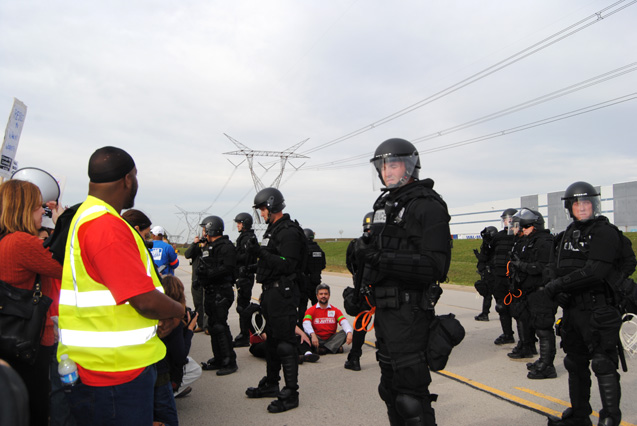Workers responsible for moving an estimated $1 trillion worth of goods a year through the global economy are paid low wages, often denied breaks and basic protective gear, and are employed primarily through temp agencies.
Outside the largest Walmart distribution center in the country, moving the products of the world’s largest private employer, a group of striking workers are asking for small changes they say will make an immeasurable difference to their working conditions. Warehouse workers in Elwood, Illinois, have been on strike for more than two weeks, calling for the subcontractors that employ them on behalf of Walmart to provide shin pads and dust masks – and to listen to their grievances around working conditions.
Early this week, workers forced the warehouse to close early after more than 200 people rallied around the suburban distribution center. A planned civil disobedience action took a surprising turn for many of the assembled protesters when riot police equipped with a sound cannon came to arrest the 17 clergy and warehouse workers blocking a road near the distribution center.
The majority of jobs created since the recession first hit mirror those the warehouse workers do: temporary, low-wage, no-benefit and high-risk. But the strike is also part of a larger trend of workers standing up to the Walmart behemoth – from the California warehouse workers on strike earlier this month to the three women that filed the latest sexual discrimination lawsuit against the company this week.
“The whole warehouse industry is built on temp poverty jobs. Every day, workers tell their sad story of getting ripped off in these warehouses, of sexual discrimination, of racial discrimination,” said Father Raymond Lescher, priest at Sacred Heart Church in Joliet, Illinois, and a member of the Warehouse Workers for Justice Board. “We’ve tried to work with politicians at the county, state and local level, but we haven’t gotten to first base. So, we said we’ve got to escalate this.”
 (Photo: Yana Kunichoff)
(Photo: Yana Kunichoff)
“There are rat feces, bat feces … it’s unbearable”
The windowless Elwood warehouse about two hours outside Chicago sits surrounded by chain link fence and empty fields. Warehouse Workers for Justice, the group helping to organize the workers, says Chicago transports half the nation’s rail freight, and seven interstate highways cross the Chicago region. It is the third-largest container port in the world, and almost $1 trillion worth of goods pass through the area annually. It has the additional distinction of being home to one of the largest concentrations of warehouses on the planet.
“If you didn’t make it yourself, it probably came through one of these warehouses,” says Leah Fried, an organizer with Warehouse Workers for Justice. Fried told Labor Notes that the Elwood location is the largest warehouse by far – 70 percent of imported products that Walmart sells make their way through its doors.
While the logistics industry working the warehouses is becoming increasingly lucrative, workers on the ground face a different reality.
 (Photo: Yana Kunichoff)
(Photo: Yana Kunichoff)
Chris Tucker, a 22-year-old resident of the neighboring suburb of Joliet, pays more than half of the income he earns as a warehouse worker on rent. With only $1300 dollars a month coming in from his job, the $850 a month to keep a roof over his head “isn’t going to cut it” for a living wage, said Tucker.
But that is only one of the reasons Tucker joined 29 other workers in walking off the job on September 15. He also says that the lack of dust masks isn’t good for his lungs, working without shin pads leaves him and others with constant bruises, and the lack of breaks during work makes the conditions dangerous.
Tucker was employed by RoadLink, the “largest private, independent North American Intermodal Logistics service provider,” according to its web site, during the three months he was at the Elmwood warehouse. Though the strikes are targeting Walmart, whose products they move, most people are employed by a series of subcontractors. Tucker has been working in warehouses for two years – along with RoadLink, he says he has worked under Velocity Logistics Inc., PLS Logistics Services, Staffing Logistics and Shamrock Logistics Operations.
 (Photo: Yana Kunichoff)
(Photo: Yana Kunichoff)
Warehouse Workers for Justice estimates that 70 percent of warehouses in the Chicago land area employ temporary labor. The group also says that Will County, where Elmwood is located, has the highest concentration of temp agencies in Illinois.
The workers have filed 11 lawsuits in the past three-and-a-half years, according to Father Lescher. Most recently, a lawsuit filed against RoadLink on September 20 in the US District Court of Northern Illinois accused the company of wage theft and not paying overtime.
A class action lawsuit filed by California Walmart warehouse workers against Schneider Logistics sheds light on the role that contractors play, showing that they set payment rates and, in the case of Schneider, set work quotas for the warehouse.
RoadLink and Walmart did not respond to requests for comment from Truthout, but Walmart told the Huffington Post it took the workers allegations “very seriously” but the complaints where “unfounded.“
 (Photo: Yana Kunichoff)
(Photo: Yana Kunichoff)
On the Picket Line
Joining the Walmart strikers on the picket line were workers from Sensata Technologies Inc., a company owned by Bain Capital and now in the final stages of moving its production to China. Workers have set up a tent camp outside the factory to protest the closings and the fact that many of them may not get their full severance packages.
Bonnie Borman worked with Sensata for more than 20 years in Freeport, Illinois, as a production technician. Now she’s not sure what she’ll do next. “All that’s left here is just minimum-wage, low-paying jobs that you can’t support a family on,” said Borman, who has already begun training her Chinese replacement. At her current job she makes $15 an hour, a wage she is worried she won’t be able to find wherever she goes to work next. “I’m kind of in that limbo place where I keep thinking: What am I going to do?”
 (Photo: Yana Kunichoff)
(Photo: Yana Kunichoff)
The world’s biggest private employer isn’t very appealing to Borman, she said.
It took Jerome Synowicz, a Walmart worker from Milwaukee, Wisconsin, eight years to move his salary from $7 an hour to his current $12. “They get you a check and it’s nothing. It’s very hard to make it go around,” he said.
Walmart Warehouse Strike.mp3 on Vocalo.org 89.5
Truthout Is Preparing to Meet Trump’s Agenda With Resistance at Every Turn
Dear Truthout Community,
If you feel rage, despondency, confusion and deep fear today, you are not alone. We’re feeling it too. We are heartsick. Facing down Trump’s fascist agenda, we are desperately worried about the most vulnerable people among us, including our loved ones and everyone in the Truthout community, and our minds are racing a million miles a minute to try to map out all that needs to be done.
We must give ourselves space to grieve and feel our fear, feel our rage, and keep in the forefront of our mind the stark truth that millions of real human lives are on the line. And simultaneously, we’ve got to get to work, take stock of our resources, and prepare to throw ourselves full force into the movement.
Journalism is a linchpin of that movement. Even as we are reeling, we’re summoning up all the energy we can to face down what’s coming, because we know that one of the sharpest weapons against fascism is publishing the truth.
There are many terrifying planks to the Trump agenda, and we plan to devote ourselves to reporting thoroughly on each one and, crucially, covering the movements resisting them. We also recognize that Trump is a dire threat to journalism itself, and that we must take this seriously from the outset.
After the election, the four of us sat down to have some hard but necessary conversations about Truthout under a Trump presidency. How would we defend our publication from an avalanche of far right lawsuits that seek to bankrupt us? How would we keep our reporters safe if they need to cover outbreaks of political violence, or if they are targeted by authorities? How will we urgently produce the practical analysis, tools and movement coverage that you need right now — breaking through our normal routines to meet a terrifying moment in ways that best serve you?
It will be a tough, scary four years to produce social justice-driven journalism. We need to deliver news, strategy, liberatory ideas, tools and movement-sparking solutions with a force that we never have had to before. And at the same time, we desperately need to protect our ability to do so.
We know this is such a painful moment and donations may understandably be the last thing on your mind. But we must ask for your support, which is needed in a new and urgent way.
We promise we will kick into an even higher gear to give you truthful news that cuts against the disinformation and vitriol and hate and violence. We promise to publish analyses that will serve the needs of the movements we all rely on to survive the next four years, and even build for the future. We promise to be responsive, to recognize you as members of our community with a vital stake and voice in this work.
Please dig deep if you can, but a donation of any amount will be a truly meaningful and tangible action in this cataclysmic historical moment.
We’re with you. Let’s do all we can to move forward together.
With love, rage, and solidarity,
Maya, Negin, Saima, and Ziggy
